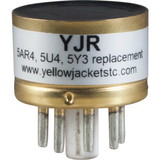5 out of 5
Customer Reviews
Items 1 - 6 of 6 reviews
1
By
S. Patterson
Date: April 26, 2022
Replaced the blown rectifier in a Mesa Boogie Lonestar Special (30W) with this and it is so pleasantly buzzy. The LSS was a little too flabby in the bass anyhow. Sounds better than the tube IMO.
Rating:  [5 of 5 Stars!]
[5 of 5 Stars!]
 [5 of 5 Stars!]
[5 of 5 Stars!]
By
Bill Hambone
Date: May 24, 2021
I popped this in my 2003 Orange AD30 single channel head, because I wanted to see if I could cut down on low end sag. I grew up playing a vintage Brownface Fender with an SS rectifier, and I'm used to that tight low end. I feel like this has made a huge improvement in the Orange. I play a lot of chords, and not much lead guitar stuff. Great $18 investment!!
Rating:  [5 of 5 Stars!]
[5 of 5 Stars!]
 [5 of 5 Stars!]
[5 of 5 Stars!]
By
baba515
Date: March 30, 2021
I use it in conjunction with a variac to reform capacitors in old tube amps. The solid state rectifier produces DC voltage right from the get go where tube rectifier doesn't until filament heats sufficiently. This allows you to start variac at very low setting to reform caps. Starting at 5 and stepping up 5 every hour. Its indispensible for this task.
Rating:  [5 of 5 Stars!]
[5 of 5 Stars!]
 [5 of 5 Stars!]
[5 of 5 Stars!]
By
flummox
Date: July 21, 2020
I installed this in my Marshall JTM45 clone to tighten up the bottom end and eliminate a point of failure. Works great. It WILL change the behaviour of your tube-rectified amp - it'll be stiffer and less compressed at high volumes, so if you want something that acts more like a tube I suggest a Weber Copper Cap. But I knew what I was getting and this does the trick just fine for me.
Rating:  [5 of 5 Stars!]
[5 of 5 Stars!]
 [5 of 5 Stars!]
[5 of 5 Stars!]
By
Wizard of WID
Date: May 07, 2016
This solid state rectifier is my preferred replacement for any vacuum tube rectifier. None of the other reviews I have read mentions a CRITICAL piece of advice that is printed on the back of the very small owner's advice packed in with the Yellow Jacket - If simply plugged in in place of a vacuum tube rectifier, the high voltage DC in your amp will come on instantly. however your power tubes are not ready for that. Full DC voltage on power tubes with cold cathodes will damage them. Solution? Install a "standby" switch to allow a warmup time, maybe 30 to 60 seconds, so that the other tubes' cathodes will be already hot when the DC voltage from the Yellow Jacket comes on. The details of that will be easy for any good old-time electronics geek: if you are not one, find a friend who is. On my amp, I installed a two-pole switch on both sides of the 670 volt AC transformer winding that feeds the two anodes of the rectifier tube.
Rating:  [5 of 5 Stars!]
[5 of 5 Stars!]
 [5 of 5 Stars!]
[5 of 5 Stars!]
By
Gordon Tubbs
Date: February 02, 2016
If you have a vintage-style amp with a tube rectifier, you probably already know how it influences your tone, so I apologize if the first part of this review is informational. "Tube sag" is basically the result of voltage getting converted from AC to DC (before it hits the power tubes). Tube rectifiers could be thought of then as the fuel injector in your car. When you step on the gas pedal, the injector can only inject so much. The same thing applies for tube rectifiers -- they can only "inject" (covert) so much voltage -- so when voltage demands are high, such as when you are playing massive chords or bass notes, the "sag sound" is amp "accelerating" (continuing the car analogy). In other words, your low-end will sound loose and flubby, which adds a lot of warmth to your tone. Solid State Rectifiers are not restricted to the limitations of vacuum tubes, and so as "fuel injectors", the voltage conversion is (relatively) instantaneous.<br /><br />The Effects.... in my AC30, there was dramatic difference in how tight the amp sounds now. The amp now has the thump of a Marshall and my pick attack is more transparent. Other than being a pain to install (AC30's are NOT service friendly), the Yellow Jacket SS rectifier fit easily and snuggly into the tube slot and that was that. However, the second reason why I got a SS rectifier in the first place is because AC30's run hot, and the CC2 series in particular slams the GZ34/5AR4 with a little too much voltage when flipping the standby switch. So, in addition the tonal improvements, my amp is now set up for better electrical efficiency (which means less internal wear and tear).
Rating:  [5 of 5 Stars!]
[5 of 5 Stars!]
 [5 of 5 Stars!]
[5 of 5 Stars!]
Items 1 - 6 of 6 reviews
1



